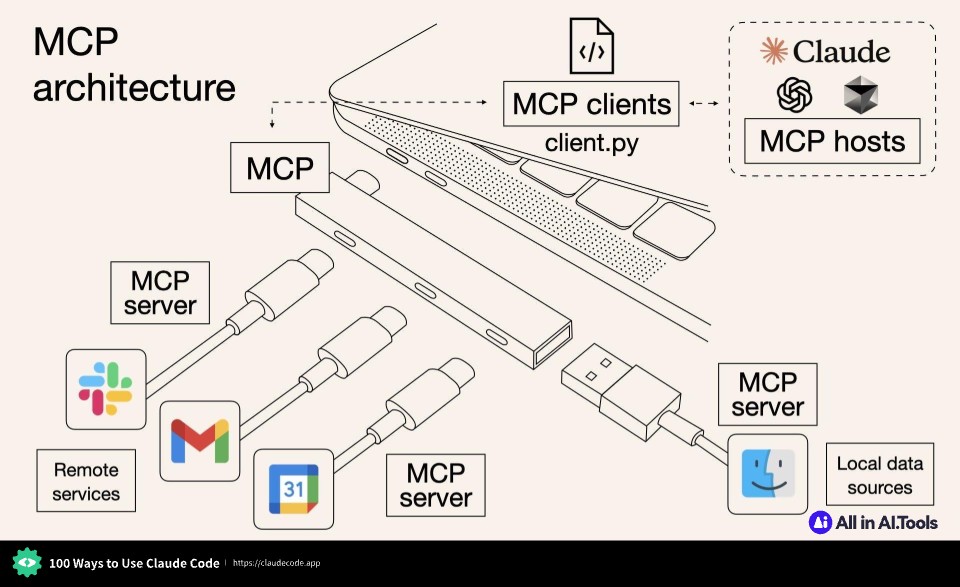Discover and integrate MCP servers to extend Claude's capabilities
Advanced MCP tool for Perplexity and OpenRouter API integration.
Telegram MCP for managing dialogs, messages, drafts, read statuses, and more.
Kakao Mobility MCP Server for directions and transit information
AWS MCP Servers — specialized MCP servers that bring AWS best practices directly to your development workflow
Talk to your cloud data using CloudZero API and Model Context Protocol (MCP) server for LLM tool calling
A powerful MCP (Model Context Protocol) server for Claude Desktop, integrating task management, SQLite, and Obsidian visualization.
MCP server for access to OpenAI's ChatGPT API with Responses API for conversation management
This is a quickstart template to easily build and deploy a custom remote MCP server to the cloud using Azure functions. You can clone/restore/run on your local machine with debugging, and azd up to have it in the cloud in a couple minutes. The MCP server is secured by design.
Elasticsearch MCP server with available features including mappings management, search and indexing, and index management etc.
TweetBinder MCP Server is a server based on the Model Context Protocol (MCP) that allows Claude and other MCP-compatible clients to interact with your TweetBinder by Audiense account
Use Figma in a MCP with Chunking Support
Secure middleware server implementing Model Context Protocol (MCP) over SSE with JWT authentication. Enables standardized communication between AI tools and clients with dynamic tool registration, request logging, and session management. Perfect for building production-ready AI systems requiring secure access patterns.
Powerful Model Context Protocol (MCP) implementation for visualizing directory structures with real-time updates, configurable depth, and smart exclusions for efficient project navigation
An MCP server that any process can pipe stdout logs to including console logs from nodejs programs
mantrachain mcp
📝 A FastMCP tool that automatically saves AI chat conversations to well-formatted Markdown files with timestamps and metadata.
🪐 MCP IPFS Server
A Model Context Protocol (MCP) server that provides weather information and alerts using the National Weather Service (NWS) API
Maintenance of a set of tools to enhance LLM through MCP protocols.
Dokumentacja problemów napotkanych podczas integracji Make (dawniej Integromat) z Claude Desktop przez protokół MCP
A Model Context Protocol (MCP) server for interacting with DaVinci Resolve and Fusion
Tools for seamless integration of different systems and services.
Cloud infrastructure and deployment management tools.
AI-powered tools for creative design workflows across 3D and 2D mediums.
AI-powered tools for product development, design review, and performance monitoring.
Tools for monitoring, analytics, and operational efficiency.


Deep dive into sophisticated SSH workflows for Claude Code power users. Learn zero-friction authentication, session management, and advanced techniques that transform your vibe coding experience.
Complete guide to optimizing CLAUDE.md files for Claude Code. Discover advanced techniques for context management, project documentation, and AI conversation optimization that enhance your vibe coding workflow.
Complete guide to setting up Claude Code on mobile devices using SSH workflows. Learn how to enable seamless AI-assisted development from your phone or tablet with proper security and network stability configurations.
Comprehensive guide to remote development best practices using Claude Code. Discover proven strategies for team collaboration, security, infrastructure management, and maintaining high productivity in distributed development environments.
MCP (Model Context Protocol) is an open protocol that standardizes how applications provide context to LLMs. Think of MCP like a USB-C port for AI applications, providing a standardized way to connect AI models to different data sources and tools.
MCP Servers are lightweight programs that expose specific capabilities through the standardized Model Context Protocol. They act as bridges between LLMs like Claude and various data sources or services, allowing secure access to files, databases, APIs, and other resources.
MCP Servers follow a client-server architecture where a host application (like Claude Desktop) connects to multiple servers. Each server provides specific functionality through standardized endpoints and protocols, enabling Claude to access data and perform actions through the standardized protocol.
Yes, MCP Servers are designed with security in mind. They run locally with explicit configuration and permissions, require user approval for actions, and include built-in security features to prevent unauthorized access and ensure data privacy.